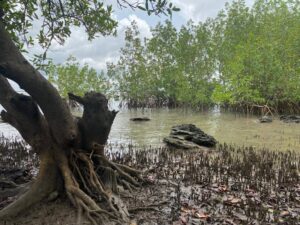Soutenance de thèse
Omar Gutierrez
LMD
Relationship and feedback between LULC changes and hydroclimatic variability in Amazonia
Résumé
The Amazon rainforest plays a vital role by functioning as a regulator of the climate system, providing essential ecosystem services and acting as the main terrestrial carbon sink. It drives hydroclimatic processes and mitigates the effects of droughts through the strong coupling exerted between the soil, vegetation and the atmosphere. Indeed, forests operate as hydraulic pumps, absorbing and linking water stored in the soil with the atmosphere. Therefore, they have the potential to impact rainfall patterns through biophysical processes like water recycling. However, these capacities have been reduced during the last decades due to disturbances in the climate-vegetation system. The hydrological cycle has intensified, and extensive forest areas have been degraded. All this has accentuated a process of biophysical transition from a predominantly forested ecosystem to a Savanna. Therefore, given these complexities, understanding the direction of changes, the impacts and their interrelationships is of vital importance.
Using multiple datasets and a Land Surface Model coupled with a General Circulation Model, this thesis delves into the study of the interactions between Amazon hydroclimatology and vegetation. In addition, it seeks to expand our understanding of modifications in the vegetation-atmosphere system and its links with climate and Land Use and Land Cover (LULC) changes. Likewise, taking into account the increasing rates of deforestation, it investigates the effects and feedback resulting from a large-scale forest loss scenario on hydrological processes and water stress.
The results show that, over the southwestern Amazon, a little-explored region, forests undergo a transition from being influenced by energy availability to depending on water availability throughout the year. During the peak of the rainy season, vegetation growth is primarily influenced by energy availability rather than water availability. Nevertheless, outside of this period and for most of the year, forests respond positively to precipitation and terrestrial water storage, suggesting that vegetation is primarily dependent on water supply. However, a spatial analysis reveals that recent deforestation modifies these transitions and destabilizes the natural balance in the climate-vegetation system.
The nature of these imbalances in the Amazon is not entirely clarified. Through an approach based on the relationships of water fluxes, energy and vegetation conditions over the last four decades, it is explored whether these changes are intrinsic to climate variability or are driven by anthropogenic processes. 67% of the southwestern Amazon has experienced a transition towards a predominantly dry state due to climatic factors (external forcing), while 21% has transitioned towards a state dominated by deforestation (internal forcing). However, external and internal forcings are not independent processes, as both mechanisms drive changes simultaneously. By weighing the magnitudes of these forcings, we show that the synergies have led 74% of the southwestern Amazon toward a state of greater water stress. Nevertheless, during recent years, although combined external-internal processes continue to exert significant control over changes, 30% of these are strictly dominated by internal forcing. This suggests that internal processes are playing an increasingly relevant role in the transition towards a state characterized by high forest water stress, especially in areas where deforestation and anthropogenic pressure are increasing.
Using the land surface component (ORCHIDEE) coupled to the atmospheric component (LMDZ) of the IPSL Earth System Model, the effects of projected deforestation by 2050 on the terrestrial hydrological cycle and dryness of the Amazon region are examined. Deforestation decreases precipitation, reduces evapotranspiration and increases runoff. In addition, it drives an increase in the runoff coefficient and a significant decrease in moisture recycling, which results in a water deficit throughout the Amazon ecosystem. In fact, deforestation accentuates water stress especially in the southwestern Amazon (positive feedback). Water demands in the atmosphere, on the land surface and even in the soil root zone intensify during the dry season. During the wet season, the deficit of specific atmospheric humidity becomes even more acute towards the tropical Andes over the Altiplano region. These findings provide a more thorough understanding of the possible effects of massive forest removal on the water availability and resilience of the Amazon in a context where changes are occurring at an accelerated rate.
Informations supplémentaires
Lieu
Salle de réunion du LMD, salle 313, Tour 45/55, 3e étage
4 place Jussieu, 75005 Paris
En visio
https://cnrs.zoom.us/j/99541344988?pwd=TXFuaEpibTV5WVcyRmJUa2tUSXNNUT09
ID de réunion : 995 4134 4988
Code secret : tTE3vm
Composition du jury
- Francis Codron
- Sabine Sauvage
- Yves Tremblay
- Sebastiaan Luyssaert
- Laurent Li
- Herve Le Treut






